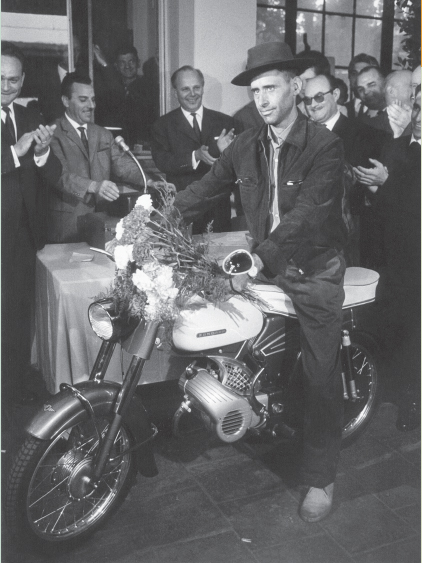Individuals in Society: Armando Rodrigues

Popping flashbulbs greeted Portuguese worker Armando Rodrigues when he stepped off a train in Cologne in September 1964. Celebrated in the national media as West Germany’s 1 millionth guest worker, Rodrigues was met by government and business leaders — including the minister of labor — who presented him with a motorcycle and a bouquet of carnations.
In most respects, Rodrigues was hardly different from the many foreign workers recruited to work in West Germany and other northern European countries. Yet given his moment of fame, he is an apt symbol of a troubled labor program that helped turn Germany into a multiethnic society.
By the late 1950s, the new Federal Republic desperately needed able-
For labor migrants, life was hard in West Germany. In the first years of the guest worker program, most recruits were men between the ages of twenty and forty who were either single or willing to leave their families at home. They typically filled low-
West Germans gave Rodrigues and his fellow migrants a mixed reception. Though they were a welcome source of inexpensive labor, the men who emigrated from what West Germans called “the southern lands” faced discrimination and prejudice. “Order, cleanliness, and punctuality seem like the natural qualities of a respectable person to us,” wrote one official in 1966. “In the south, one does not learn or know this, so it is difficult [for a person from the south] to adjust here.”*
According to official plans, the so-
Despite the hostility they faced, foreign workers established a lasting and powerful presence in West Germany, and they were a significant factor in the country’s swift economic recovery. Nearly fifty years after Rodrigues arrived in Cologne, his motorcycle is on permanent display in the House of History Museum in Bonn. The exhibit is a remarkable testament both to the contribution of migrant labor to West German economic growth and to the ongoing struggle to come to terms with ethnic difference and integration in a democratic Germany.
*Quoted in Rita Chin, The Guest Worker Question in Postwar Germany (New York: Cambridge University Press, 2007), p. 43.
QUESTIONS FOR ANALYSIS
- How did Rodrigues’s welcome at his 1964 reception differ from the general attitude toward guest workers in Germany at the time?
- What were the long-
term costs and benefits of West Germany’s labor recruitment policies?

ONLINE DOCUMENT PROJECT
What were the social and cultural consequences of the guest worker program in postwar Germany?
Keeping the question above in mind, examine a variety of perspectives on the guest worker program. Then complete a writing assignment based on the evidence and details from this chapter.
See Document Project for Chapter 28.